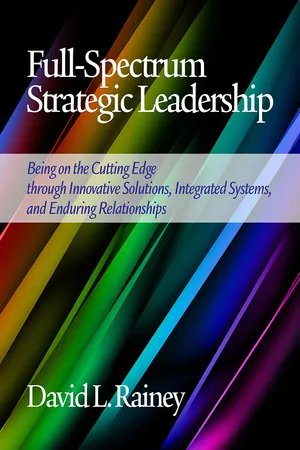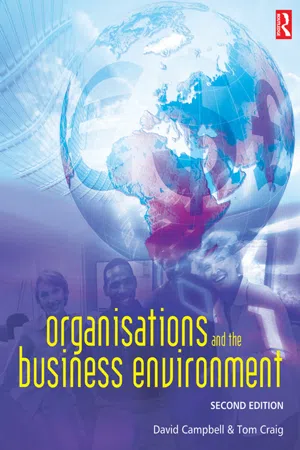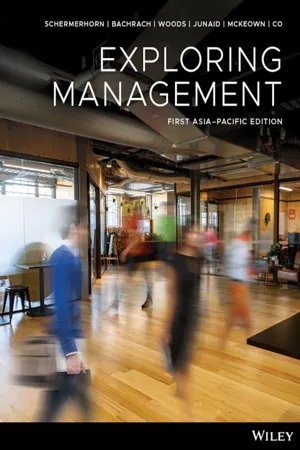Business
Social and Technological Environment
The social and technological environment refers to the external factors that impact a business, including societal trends, cultural norms, and technological advancements. Understanding and adapting to these influences is crucial for businesses to remain competitive and relevant in the market. Social and technological changes can create both opportunities and challenges for organizations, shaping consumer behavior, market demands, and industry dynamics.
Written by Perlego with AI-assistance
Related key terms
1 of 5
12 Key excerpts on "Social and Technological Environment"
- eBook - PDF
- Paul Beynon-Davies(Author)
- 2017(Publication Date)
- Red Globe Press(Publisher)
193 7 e Business environment Learning outcomes Principles Understand the relationship between the organisation as a system and the environment of the organisation. The organisation as a value-creating system interacts with actors within the wider environment. It is useful to consider four major aspects of this environment: economic, social, political and physical. Describe the nature of the economic environment of the organisation. The primary environment of a commercial organisation is the economy. Economies are systems for coordinating the production and distribution of goods/products and services. Commerce is the term normally used for that process which deals with the exchange of goods and services from producer to final consumer. Describe the nature of the social environment of the organisation. There is clear evidence that modern Western societies are now information societies. The definition of the information society relies on a critical mass of the populace using what we have called electronic delivery as their preferred method of accessing the services and products of public and private sector organisations. A number of pre-conditions exist to the successful uptake of electronic delivery: awareness, interest, access, skills, use and impact. Understand the political environment of the organisation. Traditional conceptions of law are being challenged by electronic commerce, such as the use and enforcement of contracts and intellectual property rights. Describe the nature of the physical environment of the organisation. Any activity has an impact upon the physical environment. An increasing focus has been given to the proper management of ICT to mitigate effects upon the physical environment and to reduce an organisation’s carbon footprint. - eBook - PDF
- John R. Schermerhorn, Jr., Daniel G. Bachrach(Authors)
- 2020(Publication Date)
- Wiley(Publisher)
If a business is to compete today and be around to com- pete again tomorrow, it must innovate at the intersection of environment, technology, and sustainability. 4.1 The External Environment LEARNING OBJECTIVE 4.1 Summarize key trends in the external environment of organizations. Learn More About Economic conditions • Legal-political conditions • Sociocultural conditions • Technological conditions • Natural environment conditions The general environment is made up of all external conditions that can play a part in manage- rial decision making. You might think of it as a broad set of dynamic forces that surround and influence an organization. Figure 4.1 classifies these forces as economic, legal-political, socio- cultural, technological, and natural environment conditions. Top managers and C-suite exec- utives have special responsibility for monitoring these conditions and linking them with their See Author Video The general environment consists of economic, legal- political, sociocultural, technological, and natural environment conditions in which the organization operates. Economic Environment • economic growth • unemployment rate • disposable income Sociocultural Environment • population demographics • education system • health/nutrition values Legal-Political Environment • laws and regulations • business forms • political trends Natural Environment • “green” values • recycling infrastructure Technological Environment • IT systems/infrastructure • broadband Internet access Organization FIGURE 4.1 Sample elements in the general environments of organizations. The External Environment 71 organization’s mission, strategy, and activities. You can say that their job is to make sure that the voice of the environment gets heard within the organization. Cars like Ford’s Focus Elec- tric and Chevy’s Bolt EV suggest that Ford Motor Company CEO James Hackett and General Motors’ CEO Mary Barra may be listening. - eBook - PDF
- Ricky Griffin(Author)
- 2021(Publication Date)
- Cengage Learning EMEA(Publisher)
Cengage Learning reserves the right to remove additional content at any time if subsequent rights restrictions require it. 65 CHAPTER 3 | UNDERSTANDING THE ORGANIZATION’S ENVIRONMENT of digital technology into all areas of business is also a reflection of the technological dimension. Another recent advancement is the rapid growth of integrated business software systems. The Doing Business on Planet Earth feature illustrates another connection between technology and business. The Sociocultural Dimension The sociocultural dimension of the general environment includes the customs, mores, values, and demographic characteristics of the society in which the organization functions. Sociocultural processes are important because they determine the products, services, and standards of conduct that the society is likely to value. In some countries, for example, consumers are willing to pay premium prices for designer clothes, whereas the same clothes have virtually no market in other countries. Consumer tastes also change over time. Preferences for color, style, taste, and so forth change from season to season, for example. Drinking hard liquor and smoking cigarettes are less common in the United States today than they were just a few years ago. And sociocultural factors influence how workers in a society feel about their jobs and organizations. Appropriate standards of business conduct also vary across cultures. In the United States, accepting bribes and bestowing political favors in return are considered unethical (as well as illegal). In other countries, however, payments to local politicians may be expected in return for a favorable response to such common business transactions as applications for zoning and operating permits. The shape of the market, the ethics of political influence, and attitudes in the workforce are only a few of the many ways in which culture can affect an organization. Figure 3.2 shows that McDonald’s is clearly affected by sociocultural factors. - eBook - PDF
- David L. Rainey(Author)
- 2008(Publication Date)
- Information Age Publishing(Publisher)
Figure 2.1 The dimensions of the business environment 14 46 Full-Spectrum Strategic Leadership The business environment is dynamic. There are no starting or ending points. However, it is useful to think about the social dimension first, since business is about people and people drive markets and the associated opportunities and challenges. The social dimension covers a broad array of elements about how people live and behave. It might also include the political and ethical dimensions, since they relate to people as well. But, for the sake of thoroughness, the latter two are classified as separate dimensions. The political dimension involves political systems, governance, public policy, and laws and regulations. The ethical dimension includes non-tradi- tional, more intangible forces that focus on the principles and universal standards of proper behaviors and practices across the business world, especially in countries that lack good governance or legal and regulatory mandates. The technological dimension involves all of the existing technologies, intellectual capital, innovations, and sources of knowledge and learning. The environmental dimension, also referred to as the ecological dimension, is possibly the broadest and most challenging to understand and deal with. It covers the critical elements of the natural environment that provide resources and ingredients, are affected and impacted by businesses, and are essential for life and nature. In traditional management constructs, the natural environment and the social/ human world are often viewed as subordinate to the market spaces and the other ele- ments of the business environment because most of their main elements and impor- tant factors are not directly or even indirectly related to the company’s strategies and actions. But great care has to be exercised when making such assumptions. What may be tangential to one’s business interests today could be the most exciting opportunities tomorrow. - Available until 4 Dec |Learn more
Strategic Marketing
An Introduction
- Tony Proctor(Author)
- 2002(Publication Date)
- Routledge(Publisher)
Organizations need to respond and adapt to changing environmental conditions if they intend to survive. They can even instigate changes in the environment which are in their own interests. Both demand an understanding of those factors and forces which bring about change in the environment. Ideally, an organization should adapt to changes as they occur, even anticipate them in advance or systematically instigate changes to its own advantage. An inability to do so can put organizations in positions where their shor t- and long-term survival is jeopardized. The business environment is the setting within which a business operates, formulates policies and makes decisions. It is usual to distinguish between the inter nal and the exter nal environment. The for mer usually comprises the various assets and resources possessed by the organization. That is its workforce, plant and machiner y, know- how, financial resources, etc. The latter refer s to people, institutions and developments, etc. which exer t an external influence on how the organization performs. Of course, with the emergence of strategic alliances and networks such a definition of boundaries does tend to become more blurred.Firms need to know all about the business environment in which they operate. It is essential that they can anticipate the changes that are likely to take place in the marketing environment in the foreseeable future. However, as noted above, it is not simply a matter of adapting to change. Organizations can also exercise their own influence on the environment. Among the ways that this can be achieved is the development and commercialization of new technological ideas. These new technologies then become par t of the business environment and in their turn have an impact upon what other organizations can do.Considerable control can be exercised over its internal environment by a firm, but a firm cannot exert control in the same way or to the same extent over the external environment. It can only attempt to influence it. There are various ways of influencing events in the external environment. These may include activities such as lobbying among leg islative g roups. The latter is what organizations often do when tr ying to influence the for mulation of European Community directives which can have an impact on such things as product design safety standards, etc. - eBook - ePub
People Practice
A Complete Guide
- Karen Waite, Kathy Beevers, Nicky Small, Keith Tomlinson, Shazad Hussain(Authors)
- 2021(Publication Date)
- CIPD - Kogan Page(Publisher)
If we consider some of the organisations we know, and what has impacted or created pressure points on their business, we might think of political changes such as Brexit in the UK, world events such as Covid-19, ongoing technological developments, or maybe factors affecting staff such as skills shortages. Just this simple quick consideration reminds us of how turbulent and ever-changing the business environment can be and therefore the need for organisations to manage this turbulence if they are to survive and prosper.We can refer to the business environment as operating at two levels – macro and micro. Macro level refers to the societal level and the major uncontrollable external forces (economic, demographic, technological, social and cultural, legal and political) which will influence a company’s decision-making and impact its performance. Micro level is specific to an organisation’s internal and immediate environment, factors such as its suppliers, customers, competitors and resellers, which directly influence it on a regular basis. The micro level is sometimes also known as ‘the task environment’ as this is usually the area where an organisation can influence and respond, whereas it has very little control over the macro environment.Figure 1.1 The macro and micro environmentFigure 1.1 detailsThe micro environment of the organization shows the customers, resellers, the public and soldiers. The macro environment includes political factors, economic factors, social factors, technological factors, legal factors, environmental and factors.Regularly scanning the business environment affords organisations the chance to stay ahead of changes that may impact their business and to plan for these, either capitalising on or minimising their impact.There are a number of tools and techniques which enable this ‘scanning’, including the popular SWOT analysis. SWOT stands for Strengths, Weaknesses, Opportunities and Threats. Strengths and weaknesses are internal factors whereas opportunities and threats are external factors. A SWOT analysis assesses these four aspects of a business, identifying what the organisation is doing well or not well, and so informing further strategy and organisational development. Figure 1.2 - eBook - ePub
- Tom Craig, David Campbell(Authors)
- 2012(Publication Date)
- Routledge(Publisher)
The Sociological Environment
DOI: 10.4324/9780080454603-11Learning Objectives
After studying this chapter, students should be able to describe:- the nature of the sociological environment;
- the nature of demography and how it can affect organisations;
- the relationship between education and organisation skill requirements;
- the changing patterns of employment;
- the impact of societal values, attitudes and behaviours;
- the fashions and trends in opinion and preferences that can affect organisations.
11.1 What Is the Sociological Environment?
In one sense, sociological influence on an organisation can come from any internal or external source involving people. This clearly includes a wide variety of possible stakeholder influences, such as customers, employees, suppliers, opinion leaders and trade unions.The sociological environmental presents two important facets which are relevant to business:- the features of the population, including its size, distribution, composition and changes (demography);
- the opinions, beliefs, cultural norms and preferences of the population.
11.2 Demography
What is Demography?
Demography is the study of human population dynamics. The scope of the subject includes:- the size of the population in the country (or a region) as a whole;
- growth or decline in the population (birth and death rates);
- the composition of the population by geographic location and distribution;
- the composition of the population by skill and education level;
- the composition of the population by concentration and density;
- the composition of the population by age and gender profile;
- the composition of population by its economic activity (e.g. the size and structure of the working population);
- changes in the population distribution by migration.
Why is Demography Important To Business?
The size, composition and distribution of the population are not just a matter of academic interest. Businesses take account of demography in a number of areas of activity. Its importance is linked to both the demand and supply sides of the market ‘equation’. - eBook - PDF
- John R. Schermerhorn, Jr., Paul Davidson, Daniel G. Bachrach, Peter Woods, Fatima Junaid, Tui McKeown, Mary Jesselyn Co(Authors)
- 2022(Publication Date)
- Wiley(Publisher)
4 The ability to do this begins with the answer to a basic question: what is in the external environment of organisations? The external environment comprises the set of forces and events outside an organisation that can potentially have an impact on it. The external environment is the ‘big picture’ that organisations have to respond to in order to survive and be successful. The external environment can be divided into two components, as shown in figure 4.1: the general environment (or macro environment) and the specific environment (or micro environment). FIGURE 4.1 The external environment Technology Sociocultural trends Advocacy groups Customers Organisation Industry regulation Suppliers Economy Political/ legal trends Competition S p e c ifi c e n v ir o n m e n t G e n e r a l e n vir o n m e n t N a t u r a l e n vir o n m e n t Creditors Figure 4.1 presents an overall view of an organisation and its general and specific environments. The small circle in the middle of the diagram represents the organisation. Around the organisation are its specific environments, which are encapsulated in a larger circle. Outside the large circle is the general environment. We will discuss each component in more detail in the succeeding sections. Pdf_Folio:94 94 Exploring management | 1st Asia–Pacifc edition EMERGING ISSUE Managing in crisis — how to help Chinese students locked out of Australia during COVID-19? Frank Wang exemplifes a small business owner who has successfully made changes in his busi- ness to respond to changes in his external envi- ronment. Frank was a travel agent who had to close his business during the COVID-19 pan- demic because the borders were closed for international travel. He accidentally stumbled on a business opportunity when a friend asked him to pack their belongings and send them to China. When others found out, they started approaching him for the same service. - eBook - ePub
Tourism Marketing for Cities and Towns
Using Social Media and Branding to Attract Tourists
- Bonita Kolb(Author)
- 2017(Publication Date)
- Routledge(Publisher)
The tourism marketer must also scan the external environment including, economic conditions, demographic trends, technological advancements, and socio-cultural changes. Economic factors that need to be understood include both the current state of the economy and whether it is in growth or decline. In addition, the level of disposable income available for travel must be ascertained. Technological advancements affect the consumer’s expectations of the benefits that products will provide and also the purchase process. Demographic changes in the population can provide the opportunity to target new segments of travelers. Finally, socio-cultural changes will affect people’s values, attitudes, and lifestyles. All of these issues will need to be researched before the organization is ready to start writing a strategic marketing plan. Sources of information on the external environment include analyzing the general and business news. This scanning is necessary as it is a marketing responsibility to be the person who sounds the alert if political or business events present a new challenge or opportunity.External environment- Economic: growth or decline, level of disposable income
- Demographic: age, family status, ethnicity
- Technological: product expectations, purchase process
- Socio-cultural: values, attitudes, lifestyle
Conducting research is also part of the process of scanning the external environment. Rather than interviewing the marketer will use data that is available from other organizations. This information, most of which can be obtained through conducting online research, can be used to answer questions on the economy, technological advancements, demographic changes, and socio-cultural trends. Trade and professional associations in the tourism industry will provide information on consumer trends and preferences. This information is collected as a service to their members. While these association websites, trade journals, and professional magazines have articles on demographic data, their most common use is to learn about trends in both the industry and destination choice. - eBook - ePub
Understanding Hard to Maintain Behaviour Change
A Dual Process Approach
- Ron Borland(Author)
- 2013(Publication Date)
- Wiley(Publisher)
Influences that operate or which can be changed at the level of entire societies set the agenda around which the interactional environments of individuals and their social networks operate. Some of these societal factors are taken for granted, and only when people experience other societies do they realise that they are not inevitable. Societal-level influences are a result of the laws and customs of the society, institutional forces (including commercial ones), cumulated knowledge, various forms of mass media and increasingly the role of communications technology to allow more interactive communication at a distance. These set the context that individuals and their social circles interact in and provide limits on what is possible and/or desirable.In considering where to intervene on systems, it is important to work out where the power to enact change lies, and, where possible, to act at the highest level of that power structure. That said, where there is resistance at higher levels of systems, progress can be made by acting with or on lower level processes, but only where they are part of the relevant system of control.The relatively stable environment
The environment in which people live and behave consists of the physical environment (natural and built) and within it, the social environment, both of people and the ways they communicate.A range of aspects of the environment need to be considered in analysing the likely ease of behaviour change, for either increasing or decreasing behaviours. These are briefly described in the following paragraphs.Most critical is the extent to which the micro-environment provides opportunities to act, including accessibility of places to act (e.g. access to places to exercise safely and enjoyably) on the one hand, and places where the behaviour is not normative or is actively prohibited on the other. This also includes any degree of obligation to act (e.g. places where the behaviour is expected or allowed) and any demands of the physical environment (e.g. having to go outside to smoke in freezing weather or during a rainstorm). The greater the range of places where behaviours can readily occur, the more these behaviours are engaged in. Smokers smoke less when subject to bans from smoking at work and other places [2, 3]. For recreational exercise, living near a gym or a pleasant park is associated with higher levels of exercise [4, 5]. Having safe paths for bicycle transport is leading to marked increases in the proportion of people cycling to work and other places, as well as for recreation. - eBook - ePub
The Entrepreneurial Personality
A Social Construction
- Elizabeth Chell, David E. Wicklander, Shane G. Sturman, L. Wayne Hoover(Authors)
- 2008(Publication Date)
- Routledge(Publisher)
Hence, I shall focus on the socio-economic framework in which entrepreneurs take business decisions. Layers of context from the macro- to the micro-environment will be assumed to form the structural background. The aim is to dig deeper into this complexity, assuming a theoretical frame of structure and agency. The treatment of the macro-environment will include understanding of the institutional framework that constrains or enables human action; at the meso-level I focus on the firm as an organising framework in which entrepreneurial decisions are taken, and at the micro-level I shall deduce the implications for entrepreneurs and entrepreneurial teams as dynamic economic decision-makers and agents of socio-economic change. The macro socio-economic environment Macro-environments as traditionally dealt with by economists have made deterministic assumptions about national and international contexts framing competitive behaviour. Trading conditions and the degree of environmental ‘turbulence’ have been pointed up as immutable contexts that shape and influence business and firm behaviour (Burns and Stalker, 1961; Miller, 1983; Casson, 2005). The environment is formed by a complex of socio-economic, political and legal sub-systems that are interwoven yet analytically distinct. Indeed, they are further complicated by the physical, the technological and the religious environments. There is a sense in which the environment is ‘out there’ (i.e. has a history and duration independent of the firm or entrepreneur), and another sense in which environments are internalised, produced and reproduced by actors and agents (Giddens, 1984; Craib, 1992). In grasping this complexity, we wish to consider how we might think of environments analytically: what the process is by which entrepreneurial behaviour is shaped and constrained or, indeed, enabled by the socio-economic environment. In pursuing this understanding, we should consider a number of theoretical issues - eBook - PDF
- Richard M. Steers, Luciara Nardon, Carlos J. Sanchez-Runde, Ramanie Samaratunge, Subramaniam Ananthram, Di Fan, Ying Lu, Ramanie Samaratunge, Subramaniam Ananthram, Di Fan, Ying Lu(Authors)
- 0(Publication Date)
- Cambridge University Press(Publisher)
This can be thought of as the micro environment in which managers work and is heavily influenced by prevailing cultures and institutions. Organisational culture may either replicate or reject national cultural values and norms, creating a micro environment in which national norms are reinforced or do not apply. For example, even though punctuality may not be the norm in a particular cultural environment (e.g., Greece), an organisation in that country may reject this cultural norm and enforce punctuality in its activities for very sound reasons (e.g., maintaining global flight schedules at Olympic Air). Indeed, many global organisations deal with the challenges posed by multiple national cultures by creating clear behavioural guidelines across the organisation. To succeed in any of these jobs, it is imperative that managers understand as much as possible about the organisational environment in which they work. In this chapter, we examine four aspects of organisations as they relate to managerial performance in the field: global strategy, organisational structure, organisational decision-making, and corporate culture. Throughout, the role of stakeholders, market pressures, and economic constraints in helping shape the organisational environment will become evident (see Exhibit 4.1). Stakeholders and global strategies (Who do we benefit and how?) Organisation design (How do we organise our business?) Decision- making processes (How do we make decisions?) Corporate culture (What is our personality as an organisation?) Exhibit 4.1 The organisational environment of global management 4 Organisational environments 91 Stakeholders and global strategies Simple logic – not always a good guideline for global interactions – suggests that strategy-making follows a relatively predictable format, often referred to as the strategic management cycle. The relationships involved in this cycle have been seen largely in terms of a one-way causal relationship.
Index pages curate the most relevant extracts from our library of academic textbooks. They’ve been created using an in-house natural language model (NLM), each adding context and meaning to key research topics.











